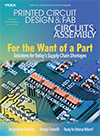Products
Thermofilm heat-activated films are said to resist heat, solvents and plasticizers and provide high-cohesive strength for long-term performance. Have a relatively low bonding temperature, for use on temperature-sensitive substrates.
Thermofilm heat-activated films form permanent bonds to metal, plastic, ceramic and woven materials. Can be used for assembly of memory cards, mobile phones, smart cards, flex circuits and print cartridges.
Scapa Industrial, www.scapaindustrial.com
Thermofilm heat-activated films form permanent bonds to metal, plastic, ceramic and woven materials. Can be used for assembly of memory cards, mobile phones, smart cards, flex circuits and print cartridges.
Scapa Industrial, www.scapaindustrial.com
KIC Vision is an automatic profiler designed to eliminate manual tasks associated with profiling for reflow ovens. Said to run in the background continuously and automatically and provide profiles as frequently as once per hour. Relies on embedded sensors in the reflow oven and Virtual Profiling software to accurately measure the product profile. Reportedly, the product profile – after a baseline - is automatically measured and logged. Measured profile data said to include peak temperature, soak, fit to process window and more.
KIC, www.kicthermal.com
Servo-Flo 801-HV meter-mix dispensing system is designed to apply small precision beads and metered shots of precisely mixed resins. Said to provide longer bead lengths and an increased quantity of metered shots. Reportedly provides consistent and repeatable bead profiles and a change of flow rate during the dispense cycle.
Is designed to provide a variety of preset profiles and dispense results from 0.2 to 18 cc at a 1-to-1 ratio. Can be preset to vary flow rate during dispensing in automated, indexing, XYZ-motion and robotic processes.
Includes special mix-dispense long-life valve for high-cycle applications. Disposable mixers dispense epoxies, polyurethanes, silicones and acrylics.
Sealant Equipment & Engineering Inc., www.sealantequipment.com
Is designed to provide a variety of preset profiles and dispense results from 0.2 to 18 cc at a 1-to-1 ratio. Can be preset to vary flow rate during dispensing in automated, indexing, XYZ-motion and robotic processes.
Includes special mix-dispense long-life valve for high-cycle applications. Disposable mixers dispense epoxies, polyurethanes, silicones and acrylics.
Sealant Equipment & Engineering Inc., www.sealantequipment.com
The VSA-1214 and VSA-1215 Vibration Spectrum analyzers are PDA-based and enable use of vibration analysis in monitoring, predictive maintenance, and routine troubleshooting to reduce costs and downtime. Include reporting software that imports data from the analyzer into an Excel-based application.
Reportedly displays and records overall vibration and ISO vibration severity alerts, as well as acceleration waveforms with a resolution of up to 6,400 points (3,200 points for the VSA-1214); and acceleration, velocity, or displacement spectra with up to 3,200 lines of FFT resolution (1,600 FFT lines for the VSA-1214). User-selectable maximum frequencies are said to range from 50 Hz to 20 KHz (50 Hz to 10 KHz for the VSA-1214).
Datastick, www.datastick.com
BluePrint Foundation, a software program that automates PCB documentation, is said to allow quick creation of comprehensive, electronic PCB fabrication and assembly instructions.
Features include unlimited PCB Views; hyperlinking; automatic ECO updates; full word processing with spell check; exotic file importation, and Web publisher. Is 100% compatible with BluePrint-PCB and allows users to mix and match configurations.
Features include unlimited PCB Views; hyperlinking; automatic ECO updates; full word processing with spell check; exotic file importation, and Web publisher. Is 100% compatible with BluePrint-PCB and allows users to mix and match configurations.
Is available now and starts at $2,750 with additional modules beginning at $500. Thirteen months of free maintenance for any purchase before Dec. 31.
Downstream Technologies, www.downstreamtech.com
Downstream Technologies, www.downstreamtech.com
The Eclipse MA100 microscope is designed for routine observation and analysis of prepped material and metallurgical samples for automotive, aerospace, medical device and electronics applications.
Can be used with Nikon Digital Sight Camera and NIS Elements software for image capture and analysis.
Features CFI60 objective lenses and a polarizer/analyzer single-action mechanism.
Nikon, www.nikonusa.com
Can be used with Nikon Digital Sight Camera and NIS Elements software for image capture and analysis.
Features CFI60 objective lenses and a polarizer/analyzer single-action mechanism.
Nikon, www.nikonusa.com
Press Releases
- Altus Reports Growing Demand for Guidance on Convection Reflow Oven Specification
- Coherix Opens New Adhesive-Dispensing Vision Center in Europe
- Pan Pacific Strategic Electronics Symposium Program Finalized
- The Most Critical 2 Inches in SMT Manufacturing – When a Splice Fails, the Line Fails, Full Stop. Throughput and Yield Depend on One Overlooked Moment


